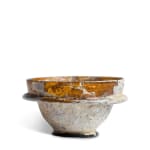Roman
A Roman amber glass acetabulum cup, Eastern Mediterranean, circa 1st-2nd century AD
Glass
Diameter: 7.7 cm
The late Imperial heavy blown clear glass dish with a nearly hemispherical bowl rising from a flanged foot, the mouth of the vessel flanged and folded back on itself, the...
The late Imperial heavy blown clear glass dish with a nearly hemispherical bowl rising from a flanged foot, the mouth of the vessel flanged and folded back on itself, the rim rising as a straight wall. With white pearlescent patina.
Provenance
British private collection, by 1955With Antiquarium Limited, New York, 1998
Literature
These vessels, known as acetabulum, were named from the Latin word acetum meaning vinegar and abulum the suffix denoting a small vessel. As today, the Romans believed vinegar was good for the constitution and such cups served as tableware to serve (vinegar) sauces. They were also used as a measure: 0,068 litre (Hilgers 1969). They are closely related to the cast monochrome and mosaic patella cups.This vessel belongs to Isings form 69a and Vessberg pyxis type B.II. For examples of the type cf. S.B. Matheson, Ancient Glass in the Yale University Art Gallery, Yale, 1980, p.36-7, no. 106 and D. Whitehouse, Roman Glass in The Corning Museum of Glass, vol.1, Corning, 1997, 84-88, particularly nos. 117-8.
Iridescence was not an intentional effect in antiquity. It is caused by alkali being leached from the glass by slightly acidic water present in soil. This causes the formation of fine layers that eventually flake off causing a prism effect on light bouncing off and passing through the surface.



